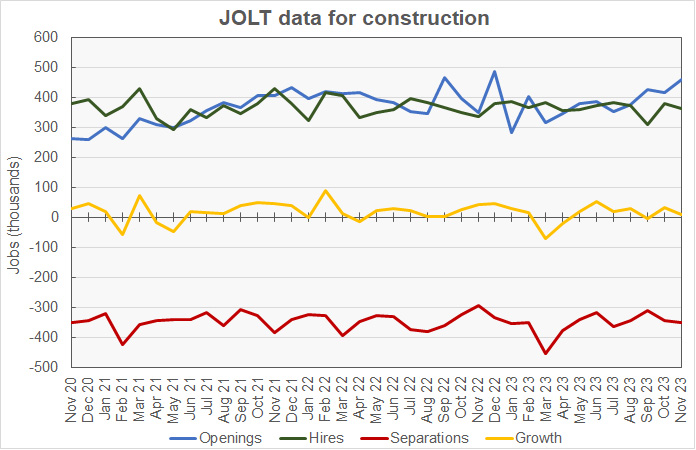The Job Openings and Labor Turnover (JOLT) report from the Bureau of Labor Statistics (BLS) said that the number of job openings in November was 8.79 million. This was reported to be down 62,000 openings month-over-month. However, the openings figure for October was revised higher by 119,000 openings so the preliminary number of openings reported for this month is 57,000 openings higher than the preliminary number reported for last month. Job openings were down 1,956,000 openings from the year-ago level.
Hiring was down from last month’s revised (-58,000) figure for the economy as a whole, falling 363,000 to a level of 5.47 million hires. Total separations fell 292,000 from last month’s revised (-14,000) figure to a level of 5.34 million. Within total separations, quits were reported to fall 0.1 percent while the layoffs rate was effectively unchanged. Quits represented 65.0 percent of total separations for the month. A high number of people quitting their jobs generally means that people feel that jobs are readily available and that they can find better employment elsewhere.
Overall employment rises despite slower hiring
For a discussion of the JOLT report and how it relates to the Employment Situation Report, please see the paragraph at the end of this article.
The November job openings figure represents 5.3 percent of total employment plus job openings. For comparison, the unemployment rate in November was reported to be 3.7 percent and 6.29 million people were unemployed. Another 5.32 million people said that they would like a job but were not counted as being in the labor force since they were not actively seeking employment.
The excess of hiring over separations in the November JOLT report indicates an employment increase of 125,000 jobs for the month. Last month’s employment increase was revised to 196,000 jobs, down by 113,000 jobs from the gain reported last month.
Of those leaving their jobs in November, 3.47 million quit voluntarily, while 1.53 million people were involuntarily separated from their jobs. The remainder of people leaving their jobs left for other reasons, such as retirements or transfers. The portion of people quitting their jobs was down slightly from last month’s figure at 2.2 percent of the labor force. The involuntary separations rate was unchanged from last month’s revised figure at 1.0 percent.
Construction employment gains again
The first chart, below, shows the employment situation for the construction jobs market over the last 37 months. It shows that November saw a net gain of 11,000 construction jobs compared to last month’s revised gain of 34,000 jobs.

Construction jobs openings in November were reported to be 459,000 jobs, 31.9 percent higher than the year-earlier level. On a month-over-month basis, openings for construction jobs were reported to rise by 43,000 openings from October’s revised (-7,000) job openings figure. Job openings in the construction category represent 5.4 percent of total employment plus job openings, up from the 5.0 percent level reported last month.
Hiring was reported to be down by 17,000 jobs in November from the prior month’s revised (+4,000) jobs figure at 362,000 new hires. The number of construction jobs that were filled in November was reported to be up 7.4 percent year-over-year.
Construction jobs total separations were reported to rise by 6,000 jobs from the prior month’s revised (-1,000) figure to 351,000 jobs. Quits were reported to be unchanged from October’s figure at a level of 173,000 jobs.
Layoffs were reported to rise by 8,000 from October’s figure to 171,000 jobs. “Other separations” which includes retirements and transfers, were reported to be down 3,000 at 7,000 jobs. Quits represented 48.7 percent of separations for the month, up by 1.5 percentage points from the level reported last month.
RERL job openings higher but hiring down
The last chart, below, shows the employment situation for the real estate and rental and leasing (RERL) jobs category. Employment in this jobs category was reported to rise by 3,000 jobs in November.

The number of job openings in the RERL category was reported to be 135,000 jobs at the end of November. This was up 2,000 job openings from the revised (+7,000) level of the month before. Job openings in November were 21 percent lower than the year-earlier level. Job openings in the RERL category represent 5.2 percent of total employment plus job openings.
Hiring in November was down by 2,000 jobs from October’s unchanged figure at 72,000 jobs. The hiring figure was 16.3 percent below the year-earlier level.
Total separations in the RERL jobs category in November were down by 6,000 from October’s revised (+4,000) figure at 69,000 jobs. Quits were up by 7,000 from October’s revised (+2,000) figure at 42,000 jobs. Quits represented 61 percent of total separations in November, up from the revised levels of 47 percent reported in October and 53 percent in September. Layoffs were reported to fall by 3,000 from October’s revised (-1,000) figure to 21,000 jobs.
The numbers given in the JOLT report are seasonally adjusted and are subject to revision. It is common for adjustments to be made in subsequent reports, particularly to the data for the most recent month. The full current JOLT report can be found here.
Comparing the reports
The US labor market is very dynamic with many people changing jobs in any given month. The JOLT report documents this dynamism by providing details about job openings, hiring and separations. However, it does not break down the jobs market into as fine categories as does the Employment Situation Report, which provides data on total employment and unemployment. For example, while the Employment Situation Report separates residential construction from other construction employment, the JOLT report does not. The Employment Situation Report separates residential property managers from other types of real estate and rental and leasing professionals, but the JOLT report does not. However, the JOLT report provides a look at what is driving the employment gains (or losses) in broad employment categories.













